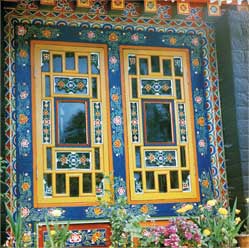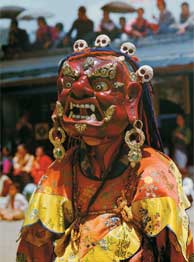| printer friendly | |||
|
|||
In Darjeeling, practical preparation for the Central-Asian expedition started. The mountain princedom of Sikkim, hidden in the Himalayas to the North of Darjeeling, amidst snowy tops and dense forest sanctuaries, became the first and a very important stage of the expedition itinerary.
“They called Sikkim the country of lightnings, and lightnings do happen here, but wouldn’t it be simpler to call it: “The country of celestial steps”? It is hard to think of a better threshold to the mysteries of the future. Unstudied, almost impenetrable country of rocks and flowers”4.
 | |
| The monastery window. Sikkim.
Photograph by L. Shaposhnikova |
Exquisite carving and colorful frescoes of the monastery buildings of Sikkim in a incomprehensible way reminded Roerich of the ancient temples of Russia: “Here they are, my dear Novgorod and Yaroslavl doors. Here it is, wonderful fresco painting. Here they are, colorful ornaments, winding around window and door frames”5. Slavic motives and patterns were guessed in Indian songs, round dances, costume elements. “Don’t let us make suppositions, or, moreover, conclusions, he wrote, but let us enter this instructive detail in the book as another guiding landmark”6.
 | |
| Dance of the God of Kanchenjunga.
Photograph by L. Shaposhnikova |
In the monasteries’ crypts, ancient manuscripts were stored. They told about the sacred country of Shambala, the borders of which were protected by inaccessible mountains and snow people. The monastery abbots and lamas, hermits and wizards told the artist about underground passages leading to the secret country, about caves concealing treasures, about sacred books falling from heaven, about stone beads “Zi” possessing healing power. The name of Maytreya, the lord of love and compassion, Buddha of the future, with whose arrival kingdom of justice will reign on the Earth, sounded.
The legends connected the source of that ancient knowledge with Kanchenjunga – the “Mountain of Five Treasures”. Once a year, the powerful god of Kanchenjunga comes down from the snowy peaks, on the day when they organize dances in his honor in Sikkim. A formidable dark-red mask covers his face. Together with frightful Mahakala, Sikkim’s protector, they perform the circles of a magic dance. The god of Kanchenjunga keeps an eye on the Treasures of the sacred Mountain and the Secret Valley.
Behind legends and myths, there was some unknown yet reality. It came to life on the Master’s canvases painted in Sikkim. Paintings of the series “Banners of the East”, “His Country”, many of which are exhibited in the hall of the Living Ethics, carried in themselves unusual, mysterious, not very familiar to Europe world. Pink snows of sacred Kanchenjunga at dawn, majestic, spiritual mountains, a white horse carrying the Treasure of the World, fabulous wise people looking like heroes of ancient times.
“In Sikkim itself, the painter noted, there was one of the Mahatmas’ Ashrams. The Mahatmas came to Sikkim riding mountain horses. Their physical presence renders solemn significance to these places. Of course, now the Ashram is moved from Sikkim. Of course, now the Mahatmas have left Sikkim. But they were here. And the silver of the chain peaks is shining even more beautifully…”7.
 | |
| The itinerary passed by the expedition in 1924 – 1928. |
N. Roerich’s paintings, essays, and diary notes about Shambala, about the Stone, about the Mahatmas – the Great Souls, custodians of secret knowledge, looked like a fairy-tale. But it was the reality with which Roerichs had already come to contact. In a small temple not far from Darjeeling, in communication with the Teachers, the final itinerary of the Central-Asian expedition was developed and its purposes were determined.
“Beside artistic tasks, Roerich noted afterwards, we planned to get acquainted with the situation with antique monuments of Central Asia in our expedition, to observe the modern state of religion, customs, and mark traces of the great migration of peoples. This last task was close to me”8.
The Central-Asian expedition caravan was unusual. It was to pass along the roads of Great wanderers and settlers, over the lands of the most ancient cultures of Asia, to find what connected many cultures in terms of time and space. The Secret Country, the Stone, the Great Souls would stand in its way like pointing landmarks.
Preparation for the itinerary was completed. Svetoslav Roerich returned temporarily to America. Nicholas Roerich with his wife and elder son started out to continue the way.
George Roerich, by the time of his arrival in India, had already got serious Orientalist education. Beside his knowledge of a few European languages, he mastered perfectly many languages of peoples of Asia, including Sanskrit and Pali. This gave an opportunity to do without interpreters not only in the way, but at destinations as well, when studying ancient monuments of culture and manuscripts in “dead” languages.
4 N. Roerich. Altai – Himalayas. – М.: RIPOL CLASSIC, 2004. – p. 63.
5Same. – p. 58.
6Quotation after: L. Shaposhnikova. Great Travel. – Book 1. Master. – М.: ICR, 1998. – p. 316.
7N. Roerich. Altai – Himalayas. – М.: RIPOL CLASSIC, 2004. – p. 27.
